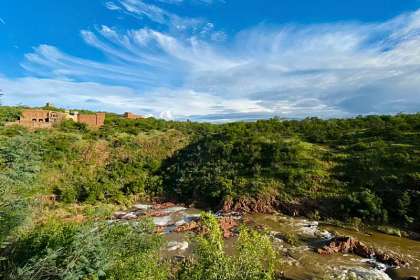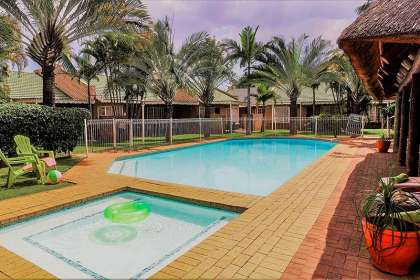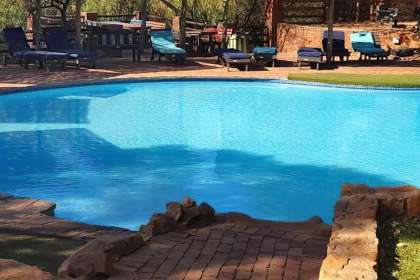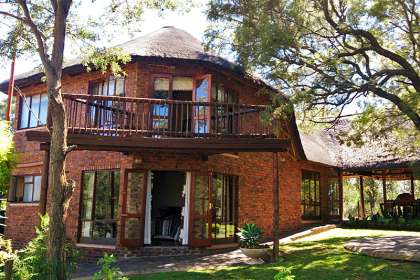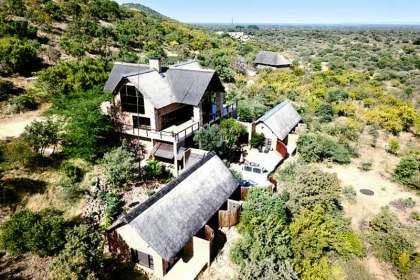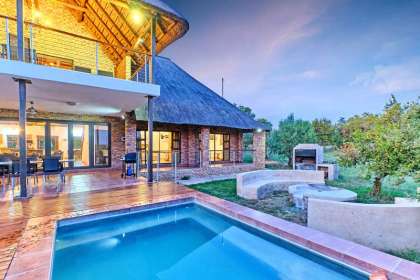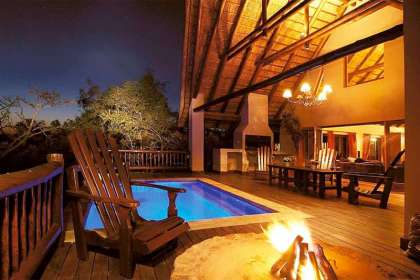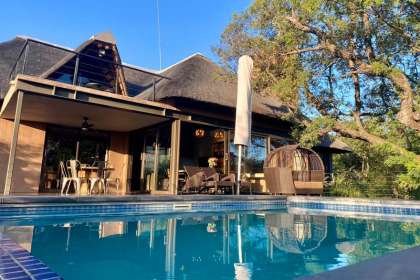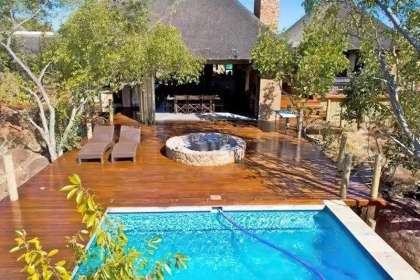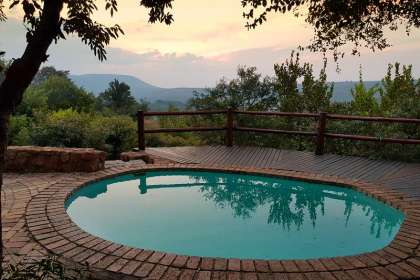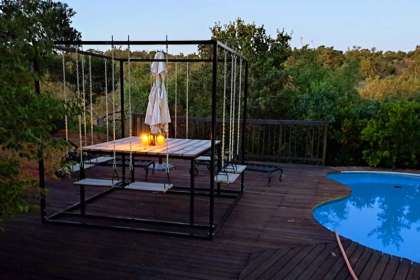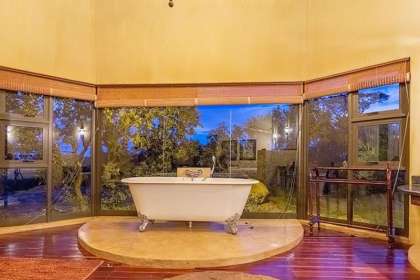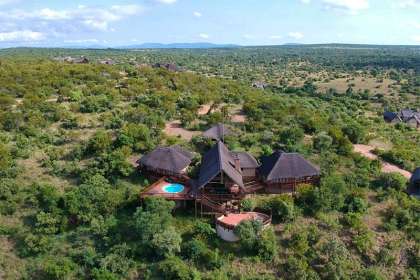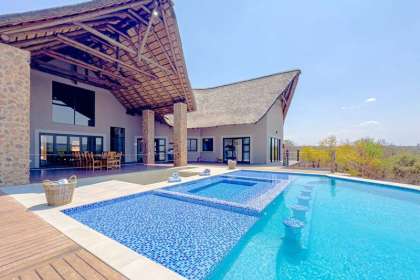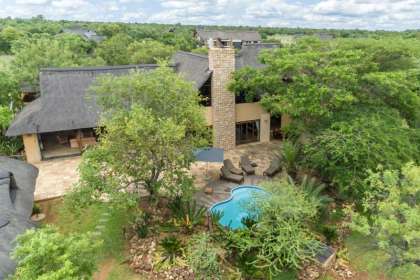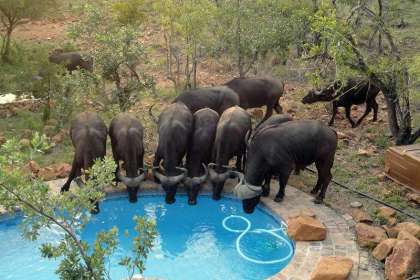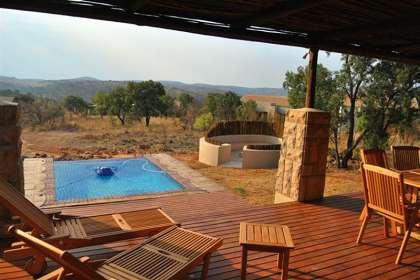Waterberg
Waterberg
The Waterberg region of the Limpopo Province of South Africa is bordered by the Limpopo River and Botswana border in the West, the provincial boundary in the South and the Magalakwena River in the East. The region is renowned for its hot spring resorts and the beautiful mountain terrain of the Waterberg mountain range. There is plenty of wildlife to be seen on the numerous private game reserves in the region. The spectacular scenery of the region ranges from broad rolling hills to magnificent red sandstone cliffs. Among the hills and mountains of the Waterberg region there is evidence of human occupation dating back thousands of years.
The Waterberg region offers more than 14 000 km of spectacular scenes. There are the Nylsvley Wetlands, where the greatest variety of water-birds are concentrated, the Cape Vulture breeding grounds near Thabazimbi, the Marakele National Park and Lapalala Wilderness Game Reserve and the many curative hot mineral springs. The most important towns of the Waterberg region are Bela-Bela (Warmbaths), Nylstroom, Naboomspruit, Vaalwater, Thabazimbi and Ellisras. Each town in itself is worth visiting, boasting a number of historical, cultural and natural attractions.
The Waterberg region of Limpopo is vast, peaceful and incredibly beautiful. It is a fascinating area with a rich cultural legacy and natural splendour. It is particularly appealing to those in need to find of a place to unwind. The Nylsvley Wetlands are home to the largest number of water birds in southern Africa with more than 400 species. The visitor can be almost guaranteed to sight more than 200 species in a single day. Visitors can stay over in the camping ground, or in one of the many lodges close by to. Bird watchers will also witness Cape Vultures as they ride the thermals over the Marakele National Park near Thabazimbi. The Park, with its rare cycads, tree ferns and yellowwood trees is home to around 800 breeding pairs.
The region encompasses vast tracts of bushveld savannah punctuated with clusters of trees and tall savannah shrubs, the extensive and mountainous Waterberg area and the Springbok Flats in the south. The Waterberg as we know it today is more than three million years old. Archaeological finds and San paintings are just glimpses of the region's past. Part of a pit prop from an Iron Age mine-shaft found in the Rooiberg area west of Bela-Bela gave a radio-carbon date of approximately 1500 AD. 500 years later mining is still an extremely important part of the economic structure of the Waterberg region, which is one of the richest areas of mineral deposits in the world, and forms part of the Bushveld Igneous Complex - a unique complex of volcanic rocks formed more than 600 million years ago and considered to be one of the geological wonders of the world. The complex extends over an area of 50 000 square kilometres, and is rich in platinum, iron ore, vanadium, tin, tungsten, chromium and coal. The region has a thriving mining industry which will last for many years to come.
The African Ivory Route, which has its origins in the legendary exploits of early ivory hunters and gold traders, runs through the Waterberg region. Today the route is an important ecotourism and 4x4 adventure destination much sought after by safari enthusiasts. Traversing rugged mountainous terrain and stunning wilderness areas, the route offers scenic camps, exciting off-roading and many other adventure opportunities for safari enthusiasts. The route will appeal particularly to the person drawn to the African wild. Scattered throughout the Waterberg region are many curative hot mineral springs where visitors can relax and enjoy a sense of well-being.
The Waterberg region in Limpopo Province, South Africa, is renowned for its stunning landscapes, rich biodiversity, and array of outdoor activities.
Here are ten things to do or see in the Waterberg region:
1. Game Viewing: Explore the diverse wildlife of the Waterberg by embarking on a game drive in one of the many private game reserves or national parks in the area. Spot the Big Five (lion, leopard, elephant, rhinoceros, and buffalo) as well as other fascinating species such as giraffes, zebras, and antelopes.
2. Hiking Trails: Lace up your boots and hit the trails to discover the natural beauty of the Waterberg on foot. The region offers a variety of hiking trails suitable for all levels of fitness, from leisurely walks to challenging treks. Don't miss the Waterberg Wilderness Trails or the Marakele Wilderness Trails for an immersive wilderness experience.
3. Marakele National Park: Visit Marakele National Park, which is home to a stunning diversity of landscapes, including mountains, valleys, and grasslands. Enjoy game drives, birdwatching, and scenic picnics while surrounded by breathtaking scenery.
4. Waterberg Biosphere Reserve: Explore the UNESCO-listed Waterberg Biosphere Reserve, which encompasses a mosaic of habitats and supports an incredible array of flora and fauna. Learn about conservation efforts and the region's cultural heritage at visitor centers and heritage sites within the reserve.
5. Hot Air Ballooning: Experience the beauty of the Waterberg from a unique perspective by taking a hot air balloon ride. Drift serenely over the landscape as you soak in panoramic views of mountains, rivers, and wildlife below.
6. Cultural Experiences: Immerse yourself in the rich cultural heritage of the Waterberg by visiting local villages, interacting with community members, and learning about traditional customs and lifestyles. Don't miss the opportunity to sample traditional cuisine and crafts.
7. Adventure Activities: Get your adrenaline pumping with a range of adventure activities available in the Waterberg, including zip-lining, abseiling, quad biking, and horseback riding. Thrill-seekers can also try their hand at rock climbing and bungee jumping.
8. Birdwatching: With its diverse habitats and abundant birdlife, the Waterberg is a paradise for birdwatchers. Grab your binoculars and head to birding hotspots like Nylsvley Nature Reserve and the Mabula Private Game Reserve to spot a wide variety of bird species.
9. Visit Bushman Paintings: Discover ancient rock art sites scattered throughout the Waterberg region, providing insights into the lives and beliefs of the area's early inhabitants. Take a guided tour to explore these fascinating archaeological sites and learn about their cultural significance.
10. Relaxation and Wellness: Unwind and rejuvenate amidst the tranquility of the Waterberg with a range of wellness activities and spa treatments offered at luxury lodges and resorts in the area. Indulge in massages, yoga sessions, and holistic therapies surrounded by the sights and sounds of nature.
Whether you're seeking adventure, wildlife encounters, cultural immersion, or simply a peaceful retreat, the Waterberg region of Limpopo Province offers a wealth of experiences to suit every traveler's interests.
- Bela-Bela - Warmbaths
- Modimolle
- Mabalingwe Nature Reserve
- Mookgophong
- Vaalwater
- Lephalale
- Mokopane
- Thabazimbi
- Kromdraai, Bela-Bela
- Leeupoort
Buffalo Thorn Safari Lodge
Self Catering House, Cottage, Chalet Accommodation in Tomburke
Waterberg
Buffalo Thorn Safari Lodge offers a self catering bush lodge experience in a private game reserve near Tomburke in the Koedoesrand district in Limpopo's Waterberg region. Buffalo Thorn Safari Lodge is situated on the Farm Engelsea only 20km... …see more for bookings / enquiries and info.
Izintaba Game Farm
Self Catering House, Cottage, Chalet Accommodation in Vaalwater
Waterberg
Izintaba Game Farm offers self catering accommodation in the Waterberg Biosphere area near Vaalwater in the Limpopo province. We offer 6 self catering options (sleeping from 4 - 15 people). Situated on a private game farm, just 290km's north of OR Tambo I …see more for bookings / enquiries and info.
Klipkuile River Bush Camp
Self Catering House, Cottage, Chalet Accommodation in Sterkrivier
Waterberg
Klipkuile Bush Lodge offers self catering accommodation near Sterkrivier in the heart of the Waterberg bushveld in the Limpopo province. Accommodation comprises of one camp for ideally 2 to 13 people. Klipkuile translates as 'Rock Pools' and refers to... …see more for bookings / enquiries and info.
Hoogland Spa Resort
Holiday Resort Accommodation in Bela-Bela - Warmbaths
Waterberg
Hoogland Spa Resort provides self catering accommodation in the heart of Bela-Bela in the Limpopo province. This holiday resort offers 11 stunning self catering chalets for the best nights sleep. We have 4-sleepers, 6-sleepers and 8-sleepers... …see more for bookings / enquiries and info.
Kokoriba Guest Farm
Self Catering House, Cottage, Chalet Accommodation in Vaalwater
Waterberg
Kokoriba Guest Farm is an affordable and private guest farm situated in Vaalwater, only 12km out on the Melkrivier Road, less than two hours drive from Pretoria offering 2 self-catering units sleeping 6 and 10 people or B&B on request. …see more for bookings / enquiries and info.
Bush Dream, Mabalingwe
Self Catering House, Cottage, Chalet Accommodation in Bela-Bela - Warmbaths
Waterberg
Bush Dream Mabalingwe is located in Mabula, 29 km from Feracare Wildlife Centre. Featuring free private parking, the chalet is in an area where guests can engage in activities such as hiking, cycling and ping pong. Mabalingwe Nature Reserve features... …see more for bookings / enquiries and info.
Hornbill Private Lodge
Self Catering House, Cottage, Chalet Accommodation in Bela-Bela - Warmbaths
Waterberg
Hornbill Private Lodge offers a self catering bushveld experience in the Mabalingwe Nature Reserve near Bela-Bela in Limpopo. Hornbill Private Lodge (sleeps 8) is a discreet private lodge situated within the 12,500 hectare big 5 game Mabalingwe Nature... …see more for bookings / enquiries and info.
Itaga View, Mabalingwe
Game Reserve And Bush Lodge Accommodation in Bela-Bela - Warmbaths
Waterberg
Itaga View offers the ultimate in self catering luxury, located in the Mabalingwe Nature Reserve near Bela-Bela in the Limpopo province. Itaga View is able to accommodate 14 guests in 4 bedrooms and an open loft all fitted with double and single beds... …see more for bookings / enquiries and info.
Shasha Lodge, Mabalingwe Game Reserve
Game Reserve And Bush Lodge Accommodation in Bela-Bela - Warmbaths
Waterberg
Shasha Lodge lies within the Cyferfontein camp of Mabalingwe Nature Reserve approximately 40kms from Bela-Bela in Limpopo. The lodge sleeps up to 20 guests (8 adults and up to 12 children). …see more for bookings / enquiries and info.
Mingwe Private Game Lodge
Game Reserve And Bush Lodge Accommodation in Bela-Bela - Warmbaths
Waterberg
Mingwe Private Game Lodge offers a self catering bush lodge experience in the Mabalingwe Nature Reserve near Bela-Bela in the Waterberg region of Limpopo. This self catering lodge has 4 en-suite luxury bedrooms (Suitable for 4 couples or 8 guests). …see more for bookings / enquiries and info.
Siyanda Lodge Mabalingwe
Game Reserve And Bush Lodge Accommodation in Bela-Bela - Warmbaths
Waterberg
Siyanda Lodge is situated in the Mabalingwe Nature Reserve and offers accommodation for up to 10 guests in a beautiful lodge with a lovely forest feel and modern finishes. The lodge comprises two en-suite bedrooms plus two lofts - one being open-plan... …see more for bookings / enquiries and info.
Feeskraal Lodge
Game Reserve And Bush Lodge Accommodation in Bela-Bela - Warmbaths
Waterberg
Feeskraal Private Safari Lodge (sleeps 8) is a luscious Waterberg Getaway, situated on the Elandsfontein Private game reserve. The Farm Elandsfontein is a private game reserve adjacent to the majestic Mabalingwe big five nature reserve. …see more for bookings / enquiries and info.
Gecko Lodge and Cottage, Mabalingwe
Self Catering House, Cottage, Chalet Accommodation in Bela-Bela - Warmbaths
Waterberg
Gecko Lodge and Cottage (sleeps 14) is a very spacious, well equipped self catering holiday house ideally located in the Mabalingwe Game Reserve. The reserves offer private and guided game drives, spa facilities, restaurants 12500 hectares of African... …see more for bookings / enquiries and info.
Milkwood Safari Lodge
Game Reserve And Bush Lodge Accommodation in Bela-Bela - Warmbaths
Waterberg
Milkwood Safari Lodge offers an authentic self catering bush lodge experience in the Mabalingwe Nature Reserve near Bela-Bela in the Waterberg region of the Limpopo province. (Sleeps 8 adults and 4 children). Ever dreamed of an 'Out of Africa' experience …see more for bookings / enquiries and info.
Tholo Lodge, Mabalingwe Nature Reserve
Game Reserve And Bush Lodge Accommodation in Bela-Bela - Warmbaths
Waterberg
Tholo Lodge provides an authentic self catering bush lodge experience in the acclaimed Mabalingwe Nature Reserve near Bela-Bela in the Waterberg region of the Limpopo province. (Sleeps 8 adults + 4 children). This is an "Out of Africa" experience... …see more for bookings / enquiries and info.
Kanaan Lodge, Mabalingwe Game Reserve
Game Reserve And Bush Lodge Accommodation in Bela-Bela - Warmbaths
Waterberg
Kanaan Lodge is located in Cyferfontein Mabalingwe near Bela-Bela in Limpopo and offers the epitome of luxury in the form of a self catering lodge. 4 bedrooms - sleeps 8 people. …see more for bookings / enquiries and info.
Tebuah Private Game Lodge
Game Reserve And Bush Lodge Accommodation in Bela-Bela - Warmbaths
Waterberg
Experience a true African sunset in the bush at Tebuah Private Game Lodge nestled in the heart of Mabalingwe Nature Reserve. The house sleeps 16 people on a self catering basis and is fully equipped. Enjoy breathtaking views from the deck. …see more for bookings / enquiries and info.
Golfers Lodge 167
Game Reserve And Bush Lodge Accommodation in Zebula Golf Estate and Spa
Waterberg
Golfers Lodge 167 is a Family lodge of 13 bedrooms located at the Zebula Wildlife and golf resort just 40km from the town Bela Bela. Escape the madness and enjoy some bushveld environment where free roaming animals add to the scenery and help... …see more for bookings / enquiries and info.
25 Cyferfontein Mabalingwe
Self Catering House, Cottage, Chalet Accommodation in Bela-Bela - Warmbaths
Waterberg
25 Cyferfontein Mabalingwe provides self catering accommodation in the Mabalingwe Nature Reserve near Bela-Bela in the Limpopo province. Get really close to nature in this fully equipped luxury home (Sleeps 6 + 4 children), ideally situated... …see more for bookings / enquiries and info.
Elements Private Golf Reserve Lodge 278
Self Catering House, Cottage, Chalet Accommodation in Bela-Bela - Warmbaths
Waterberg
Elements Private Golf Reserve Lodge 278 offers self catering accommodation in a golf estate near Bela-Bela in the Limpopo province. (Sleeps 4 adults). Set in the heart of the Bushveld, Elements Lodge No 278 is a privately owned Golf lodge... …see more for bookings / enquiries and info.

 Pride of lions begins the day at Entabeni Game Reserve ©
Pride of lions begins the day at Entabeni Game Reserve ©  Ndlovu at Entabeni Game Reserve. (Spelt indlovu in Zulu, means elephant). ©
Ndlovu at Entabeni Game Reserve. (Spelt indlovu in Zulu, means elephant). ©  Gurney's Sugarbird (Promerops gurneyi). Marakele National Park. ©
Gurney's Sugarbird (Promerops gurneyi). Marakele National Park. © 

